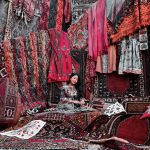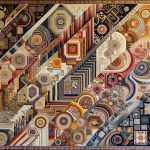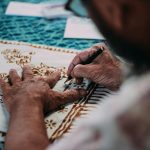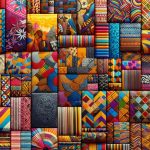Dutch batik fabric comes from a unique blend of Indonesian heritage and Dutch craftsmanship. You’ll find its roots in traditional Indonesian wax-resist dyeing techniques, adapted and innovated in the Netherlands through centuries of cultural exchange, especially during the Dutch East India Company era. Dutch batik stands out with bold patterns and vibrant colors, created using mechanized methods unlike traditional handmade batik. If you’re curious about its rich history, distinctive features, and modern uses, there’s plenty more to explore.
Table of Contents
Key Takeaways
- Dutch batik fabric originated from the Netherlands, influenced by Indonesian batik traditions brought through historical trade connections.
- It developed uniquely in the Netherlands, blending Indonesian motifs with European manufacturing techniques.
- The Dutch East India Company facilitated cultural exchanges that introduced batik to Europe in the 17th century.
- Dutch batik is produced using mechanized printing methods, differing from traditional handmade Indonesian batik.
- Its designs reflect a fusion of Indonesian cultural symbols and Dutch artistic preferences, making it distinctively Dutch.
The Origins of Batik Tradition
Although many associate batik with Indonesia, the tradition actually dates back thousands of years and spans several cultures.
When you explore batik’s origins, you’ll find evidence in ancient Egypt and India, where similar wax-resist dyeing techniques were practiced. You can trace its roots to these early methods of decorating fabric, which allowed people to create intricate patterns before modern tools existed.
As you dig deeper, you’ll notice how batik evolved independently in various regions, each adding unique styles and motifs. This rich history shows batik isn’t confined to one place but reflects a shared human creativity in textile art.
Understanding this background helps you appreciate the global journey batik has taken before becoming linked to specific cultures.
The Influence of Indonesian Culture
You’ll see how Indonesian culture shapes Dutch batik through its rich traditions and unique artistic techniques.
The symbols and patterns carry deep meanings rooted in Indonesia’s history.
Let’s explore how these cultural elements influence the fabric’s design.
Cultural Roots and Traditions
Because Dutch Batik fabric draws heavily from Indonesian culture, understanding its cultural roots reveals a rich tapestry of tradition and symbolism.
When you explore batik’s origins, you’ll find it deeply embedded in Indonesian social and spiritual life. You’ll notice how batik serves as more than just fabric—it’s a marker of identity, status, and heritage.
You’ll see families passing down batik patterns through generations, each design carrying specific meanings tied to ceremonies, rites of passage, or local beliefs.
As you engage with Dutch Batik, you connect with this legacy, appreciating how cultural values and community life influence its creation.
Recognizing these traditions helps you see batik not just as art, but as a living cultural expression rooted in Indonesia’s history.
Artistic Techniques and Symbols
Understanding the cultural roots of Dutch Batik sets the stage for appreciating the artistic techniques and symbols that shape its unique identity. When you explore Dutch Batik, you’ll notice how Indonesian culture deeply influences its patterns and methods. You’ll see intricate wax-resist dyeing, where wax preserves parts of the fabric from dye, creating detailed designs. Symbols like flowers, animals, and geometric shapes tell stories and carry meanings from Indonesian heritage.
| Technique | Description | Symbolic Meaning |
|---|---|---|
| Wax-resist dye | Applying wax to fabric | Preservation, detail |
| Floral motifs | Stylized flowers and plants | Growth, beauty |
| Geometric shapes | Repeated patterns and lines | Harmony, balance |
How Dutch Batik Differs From Traditional Batik
Although both Dutch batik and traditional batik share roots in wax-resist dyeing techniques, you’ll notice distinct differences in their production methods and visual styles.
Dutch and traditional batik both use wax-resist dyeing but differ in craftsmanship and design style.
Dutch batik often uses industrial printing methods, while traditional batik relies on hand-drawn or stamped wax applications. Here’s how they differ:
- Production: Dutch batik uses mechanized printing; traditional batik is handmade.
- Patterns: Dutch designs favor bold, repetitive motifs; traditional batik features intricate, symbolic patterns.
- Color Palette: Dutch batik often showcases vibrant, contrasting colors; traditional batik employs earthy, natural hues.
- Fabric Texture: Dutch batik fabric is usually smoother and more uniform; traditional batik fabric may have slight irregularities due to manual dyeing.
Understanding these differences helps you appreciate the unique qualities each style brings to textile art.
The Role of the Dutch East India Company
You’ll want to explore how the Dutch East India Company, starting in the early 1600s, established key trade routes that connected Europe and Asia.
Their influence shaped not only commerce but also cultural exchanges, including textile traditions like batik.
Understanding their role helps explain how Dutch batik developed its unique style.
Dutch East India Company Origins
Since the Dutch East India Company played a crucial role in global trade during the 17th century, you can’t fully grasp the origins of Dutch batik fabric without exploring this influential organization.
The company, known as VOC, was established in 1602 as a powerful trading entity. It united various Dutch trading interests to compete in Asian markets.
You should know four key aspects of its origins:
- It was the world’s first multinational corporation.
- It had the authority to wage war, negotiate treaties, and establish colonies.
- It aimed to control spice trade routes in Southeast Asia.
- It created the foundation for cultural exchanges, including textile influences.
Understanding the VOC’s beginnings helps you see how Dutch batik fabric emerged as a unique product of these early global interactions.
Trade Routes and Influence
When the Dutch East India Company expanded its trade routes across Asia, it didn’t just transport spices—you’ll also find the origins of Dutch batik woven into these journeys.
The company established strong trade links with Indonesia, especially Java, where traditional batik thrived. By importing Indonesian batik textiles to Europe, they introduced new patterns and techniques.
You’ll see how Dutch manufacturers adapted these designs, merging them with European tastes. This exchange wasn’t random; it was a calculated effort to capitalize on the growing demand for exotic fabrics.
The Dutch East India Company’s extensive network allowed batik to evolve, blending cultural elements while maintaining its core artistry.
Cultural Exchange and Impact
Although the Dutch East India Company primarily focused on trade, it played an essential role in shaping cultural exchanges between Europe and Indonesia.
You’ll notice that this interaction influenced batik fabric in several key ways. First, Dutch traders introduced European dyes and patterns to Indonesian artisans.
Second, local craftsmen adapted these elements, creating unique hybrid designs.
Third, the company facilitated the spread of batik beyond Indonesia, especially to Europe.
Fourth, this cultural exchange boosted the fabric’s popularity, leading to the creation of Dutch Batik, which blends traditional Indonesian techniques with European aesthetics.
The Evolution of Batik Techniques in the Netherlands
As you explore Dutch batik fabric, you’ll notice how the techniques have transformed over time, blending traditional methods with modern innovations.
Originally, Dutch artisans adopted the wax-resist dyeing process from Indonesian batik but adapted it to suit European tastes and industrial capabilities. You’ll see how mechanization introduced new tools that sped up production while maintaining the intricate designs characteristic of batik.
Today, you can find artists combining hand-drawn wax patterns with digital printing, creating vibrant fabrics that honor heritage yet embrace contemporary style. This evolution reflects both cultural respect and creative experimentation, allowing Dutch batik to stand out globally.
When you handle these fabrics, you’re witnessing a dynamic craft that respects its roots but isn’t afraid to innovate.
Key Characteristics of Dutch Batik Fabric
Since Dutch batik fabric blends cultural influences and modern techniques, you’ll notice several distinct features that set it apart.
First, the colors are vibrant and bold, often using synthetic dyes for consistency.
Vibrant, bold colors achieved through synthetic dyes ensure consistent and striking Dutch batik fabric hues.
Second, the patterns combine traditional Indonesian motifs with European design elements, creating a unique fusion.
Third, the fabric tends to have a smoother texture compared to traditional batik, thanks to improved production methods.
Fourth, the prints are highly detailed, reflecting precise craftsmanship and advanced printing technologies.
When you choose Dutch batik, you’re getting a fabric that embodies heritage and innovation simultaneously.
These key characteristics make Dutch batik fabric not only visually striking but also versatile for various fashion and decor uses.
The Manufacturing Process of Dutch Batik
The unique blend of vibrant colors and intricate patterns in Dutch batik comes from a carefully controlled manufacturing process.
You’ll notice it starts with high-quality cotton fabric, which artisans stretch tightly to prepare for waxing. Using a canting tool or copper stamps, they apply hot wax to outline detailed designs.
When you dye the fabric, the wax resists the color, preserving those patterns. After dyeing, the wax is removed by boiling or scraping, revealing the vivid contrasts.
This process repeats multiple times with different colors to build complex, layered motifs. You’ll appreciate how precision and patience in each step guarantee the fabric’s distinct look.
Dutch manufacturers combine traditional methods with modern techniques, maintaining quality and consistency throughout production.
The Global Popularity of Dutch Batik
Although Dutch batik originated in a specific cultural context, its appeal has spread far beyond the Netherlands. You can find this vibrant fabric embraced worldwide for its unique blend of tradition and innovation.
Its global popularity stems from several key factors:
- Distinctive, bold patterns that stand out in fashion and décor.
- High-quality craftsmanship ensuring durability and richness.
- Versatility in applications from clothing to home textiles.
- Cultural fusion that intrigues and connects diverse audiences.
When you choose Dutch batik, you’re not just selecting fabric—you’re embracing a story that travels across continents.
Its global recognition continues to grow as more people appreciate the art and history woven into each piece. This fabric’s charm truly transcends borders.
Contemporary Uses and Trends in Dutch Batik
As Dutch batik continues to capture hearts worldwide, its presence in modern fashion and design keeps evolving. You’ll see it in everything from chic clothing collections to home decor accents.
Designers blend traditional patterns with contemporary cuts, making batik fabrics perfect for stylish dresses, shirts, and accessories. You can also find these vibrant prints on cushions, curtains, and even wall art, adding a unique cultural touch to interiors.
Sustainable fashion brands embrace Dutch batik for its quality and eco-friendly production methods, so you’re supporting both style and ethics.
Whether you’re updating your wardrobe or decorating your space, incorporating Dutch batik lets you celebrate its rich heritage while staying trendy and fresh.
Keep an eye out—the fabric’s versatility means it’s only gaining momentum.
Frequently Asked Questions
What Are the Best Care Instructions for Dutch Batik Fabric?
You should hand wash Dutch batik fabric in cold water with mild detergent. Avoid bleach and wringing. Dry it flat away from direct sunlight to preserve colors. Iron on low heat if needed, and store it properly.
Where Can I Buy Authentic Dutch Batik Fabric?
If you’re hunting for authentic Dutch batik fabric, explore specialty textile shops or online marketplaces like Etsy. They often carry genuine pieces, letting you weave your own vibrant story with every yard you buy.
How Much Does Dutch Batik Fabric Typically Cost?
You’ll typically find Dutch batik fabric priced between $15 and $40 per yard, depending on quality and design complexity. Higher-end pieces or exclusive patterns might cost more, so expect some variation when you shop around.
Can Dutch Batik Fabric Be Used for Upholstery?
Think of Dutch Batik fabric as a vibrant storyteller—yes, you can use it for upholstery, but remember, its delicate design may need protection. Choose light-use pieces or add a protective finish to keep it stunning.
Are There Famous Designers Using Dutch Batik Today?
You’ll find famous designers like Duro Olowu and Stella Jean incorporating Dutch Batik into their collections today. They love its vibrant patterns and cultural richness, making your wardrobe uniquely stylish and globally inspired.
- The Use of Nonwovens in Construction and Civil Engineering - July 11, 2025
- The Use of Nonwovens in Construction and Civil Engineering - July 11, 2025
- The Use of Nonwovens in Construction and Civil Engineering - July 11, 2025







